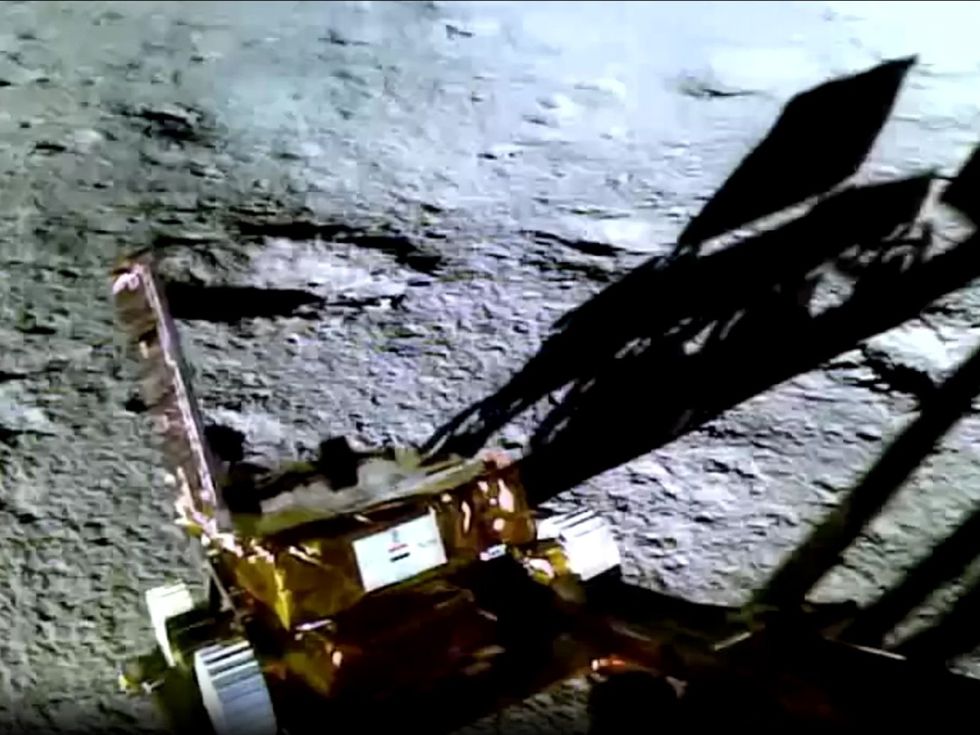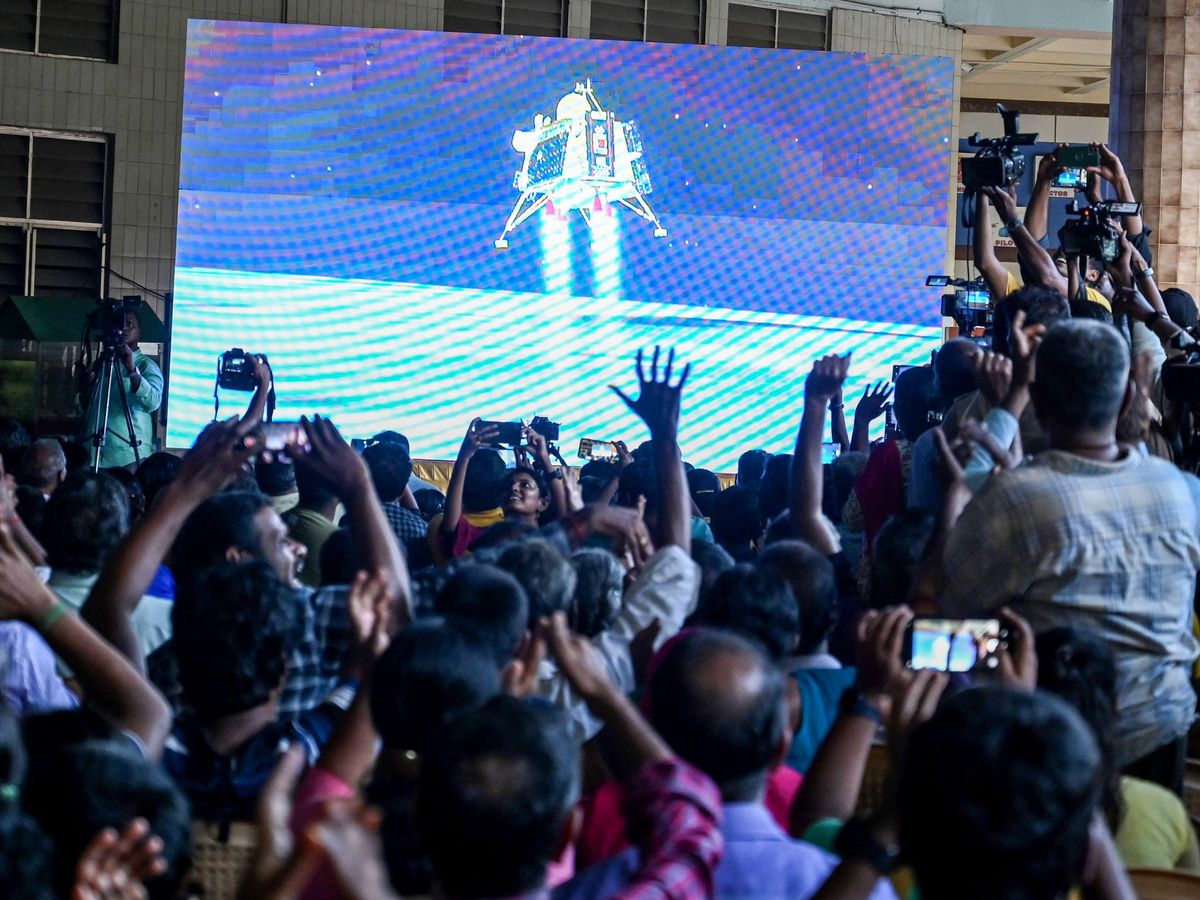India’s Chandrayaan-3 mission had to do one incredibly difficult thing: touch down on the moon. When it did, the cheers at mission control in Bengalaru could be heard in Washington and Beijing, Moscow and Tokyo, and on 8 million video screens, where coverage of the landing was streamed live on YouTube by the Indian Space Research Organization—ISRO for short.
Less than 2 minutes later, the control room fell silent—not because there was anything wrong with the spacecraft but because India’s prime minister, Narendra Modi, used the occasion to give a speech.
“This moment is unforgettable. It is phenomenal. This is a victory cry of a new India,” said Modi, speaking from an international conference in South Africa. “This is the heartbeat of 1.4 billion people.”
Chandrayaan-3, with its Vikram lander and Pragyan rover, puts India in exclusive company: Only three other countries—the Soviet Union, the United States, and China—have made successful lunar landings, and each spent many times the 6.15 billion rupees (about US $75 million) the ISRO spent.
What’s more, the craft landed in a region no one else had ever reached. Vikram now sits nearly 70 degrees south of the lunar equator, not far from the permanently shadowed craters in the south polar region, where there are likely deposits of water ice—potentially vital as fuel and water for future use by astronauts. It’s a little like choosing Prudhoe Bay, Alaska, as the first place to visit if you were exploring Earth; it’s harder to reach but may have useful raw materials. Nobody has actually determined yet whether lunar ice can be mined economically; that’s now a goal for every current effort to establish a long-term lunar presence.
To that end, the Indian lander and rover carried half a dozen scientific instruments—a 10-centimeter probe to analyze the soil’s thermal properties, an alpha particle X-ray spectrometer and so forth. But ISRO said from the start that Chandrayaan-3 was primarily a technology demonstration. Landing safely, especially after the 2019 crash of Chandrayaan-2, was the main objective. Deploying the Pragyan rover was second. The experiments were lower on the priority list.

“India’s showing under Modi’s leadership that here we are, we are a formidable power, we can execute complex missions,” says Farwa Aamer, director of South Asia initiatives at the Asia Society Policy Institute in New York. “It’s telling other countries, ’We can explore uncharted territory. So we’re influential in your international discussions. We’re a partner that you should consider.’”
In a world where the wealthy countries of Europe, America, and the Pacific Rim are sometimes referred to as “the Global North,” Wednesday’s landing solidifies India’s status as a leader of the Global South. A successful space program is often cited as one sign of a technologically sophisticated country, even as it struggles with poverty, inequality and environmental degradation. Aamer said she was heartened to see how many women there were on the Chandrayaan-3 team, and she thinks other countries will notice, too.
“What India has shown is that they now have the capability to soft-land on the moon. And it’s one of those capabilities, as Russia has proven, if you don’t use it, you lose it.” —Clive Neal, University of Notre Dame
It so happened that the Chandrayaan-3 landing site on the moon was only 3 degrees north of the intended site for Luna-25, the Russian spacecraft that lost control in lunar orbit and crashed just four days earlier. Russia had not tried a moon landing since 1976.
“What India has shown is that they now have the capability to soft-land on the moon. And it’s one of those capabilities, as Russia has proven, if you don’t use it, you lose it,” says Clive Neal, a professor of planetary geology at the University of Notre Dame, who has done extensive research on potential lunar resources. He says that despite the jockeying for position among space programs, he hopes mission leaders will see themselves as collaborators working toward a common goal.
“If we try and get ramped up into a space race, space races are not sustainable,” says Neal. “History proves that. We might get the budget that we desire for a few years, but then we will be shocked when the money stops.”
Chandrayaan-3 may not have to wait very long for company. Japan’s SLIM, short for Smart Lander for Investigating Moon, is due to go up any day now with the goal of making a pinpoint landing within a 100-meter circle on the lunar surface. To save fuel it will take four months to get there. Two American probes may also launch by year’s end, though, like many missions, they’ve been delayed by technical problems. One is called Nova-C IM-1, made by a Houston-based company, Intuitive Machines. The other, Peregrine Mission 1 from Pittsburgh’s Astrobotic Technology, carries a tiny rover called Iris. Both are privately organized, though NASA is backing them and paying to fly small payloads on each.
The next Indian moon mission has been in the works for three years. The mission, to be conducted jointly with Japan, is sometimes called Chandrayaan-4, though more often it uses the name LUPEX, short for Lunar Polar Exploration Mission. It involves a rover with a suite of instruments, and it may well go to one of the permanently shadowed regions, where science suggests ice has never had a chance to sublimate. India will provide the landing ship, Japan the launch rocket and rover. Mission planners hope to probe more than a meter beneath the surface; if there’s usable ice there, LUPEX may provide helpful data. The launch from Japan could happen in 2025 or 2026.
But for now there is still the afterglow of Chandrayaan-3. The lander and rover are solar powered, and ISRO said before the flight that it would be very surprised if they survived the cold of the two-week-long lunar night. But the mission was a success the minute touchdown was confirmed.
This article was updated on 30 August 2023.
- How to Hasten India's Transition Away From Coal - IEEE Spectrum ›
- How India, the World's Largest Democracy, Shuts Down the Internet ... ›
- Intuitive Machines IM-1 Tries First Private Lunar Landing - IEEE Spectrum ›
- Full Moon: Interlune Startup Aims to Mine for Helium-3 - IEEE Spectrum ›
Ned Potter is a New York writer who spent more than 25 years as an ABC News and CBS News correspondent covering science, technology, space, and the environment.



